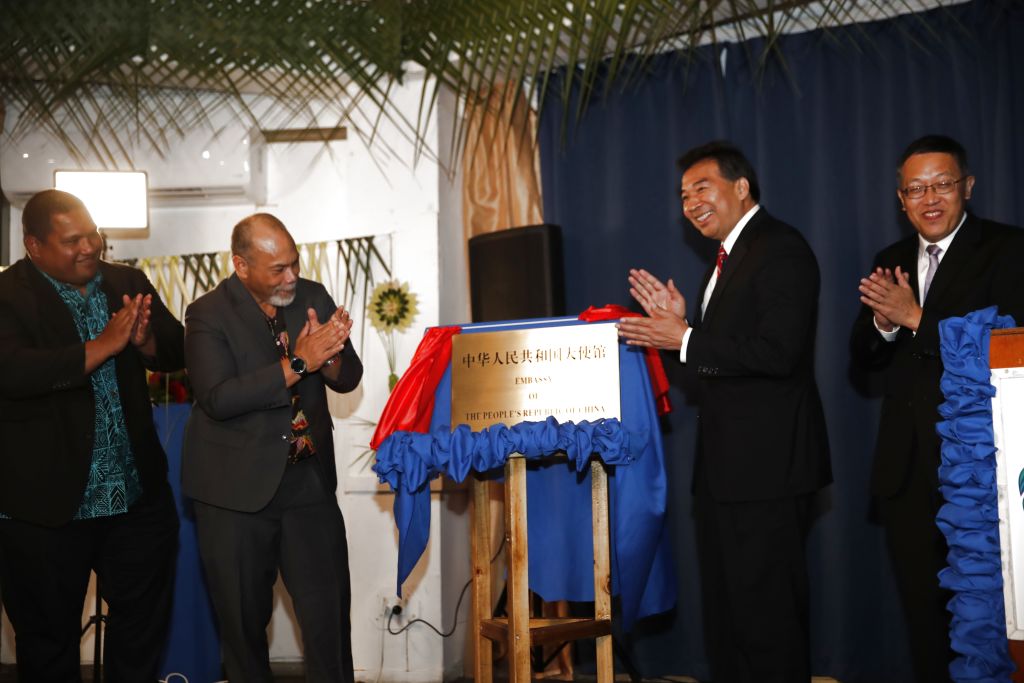
On 14 January, Nauru re-established diplomatic relations with the People’s Republic of China (PRC) ending nearly 20 years of links with Taiwan. The news came as a surprise to some, especially since former Nauru President Russ Joseph Kun visited Taipei with great fanfare in October 2023. Nevertheless, Nauru’s switch to Beijing was certainly welcome to Chinese companies one of whom, China Harbour Engineering Company (CHEC), has been working in Nauru on a port development project since May 2023.
Much has been written about the geostrategic implications of Nauru’s decision regarding the US-China competition for influence in Oceania; however, the focus on state intent has left a number of important actors, not least Nauruans, on the sidelines. Chinese companies, who have wide-ranging interests and an influential presence in Oceania, are also often overlooked in regional analyses and the Nauru switch proved no different.
Our November 2023 article, Mapping PRC companies in the Pacific, places Chinese companies centre stage in the changing political and economic landscape of Oceania. We compiled data from publicly available sources, including local media reports, company reports, state records, and the Lowy Institute’s Pacific Aid Map. In addition, we discussed the grounded impacts of Chinese companies on Solomon Islands and Fiji to spotlight their role as profit-driven enterprises, and diplomatic actors.
Investments from the PRC in the region have surged in both volume and value, reaching a total of US$2.72 billion by the close of 2021. The construction and real estate sectors of numerous Pacific Island Countries (PICs) have witnessed a dominance by Chinese construction companies, reflecting both the infrastructure requirements of PICs and the domestic political dynamics of the PRC.
Notably, development banks, with the Asian Development Bank (ABD) at the forefront, have played a crucial role in sustaining and expanding the presence of PRC construction companies in the Pacific. A 2015 run on China’s foreign reserves to defend the yuan meant that funding available from concessional loans slowly tapered off in 2016. Between 2008-2021, the ADB was the second largest overseas development partner to Oceania. By 2019, 75% of China Civil Engineering Construction Corporation (CCECC) projects in Vanuatu and 90% of CHEC projects in Papua New Guinea were financed with non-Chinese sources, most notably by the ADB.
The distribution of companies varies widely, with notable players like CCECC and CHEC, the Nauru trailblazers, involved in projects across diverse Pacific countries. Some companies focus on specific countries, such as Shanghai Construction Group in Samoa, China Railway First Group in Fiji, and China National Overseas Engineering Corporation (COVEC) establishing a lasting presence in PNG.
Despite their economic significance, these leading companies face increasing pressure to align with the interests of the PRC party-state. This party-state expectation doesn’t always meet with the perspectives of project managers on the ground, typically from a civil engineering background, who have a limited interest in political affairs. This phenomenon isn’t exclusive to the Pacific or the developing world, as PRC overseas subsidiaries experience a shift towards prioritising party loyalty over commercial orientation in recruitment and promotion.
Instances of PRC construction companies furthering the interests of the party-state in the region are evident, such as CCECC’s Port Vila based delegation lobbying Solomon Islands Prime Minister Sogavare in 2019 for a diplomatic switch from Taiwan to the PRC. Its venture into diplomacy has yielded benefits. Following the transition, CCECC was in a favourable position to secure a variety of projects from Chinese, local, and multilateral sources.
Meanwhile, in Nauru, CHEC won two ADB-backed projects, the solar power development project and the aforementioned port development project. The second of these projects, with an overall value of US$80 million, aims to convert the Aiwo Boat Harbor into Nauru’s first international and cargo terminal, critical to enhancing trade and connectivity.
Without a smoking gun, there isn’t compelling evidence to suggest CHEC had a hand in Nauru’s recent switch from Taiwan; nevertheless, China’s party-state tabloid Global Times, citing an interview with Zhu Wei, vice-manager of CHEC’s Nauru port project, noted that ‘Chinese engineering companies are expected to look for new opportunities, with hopes of undertaking more construction projects and collaboration opportunities’.
The possibility of Tuvalu breaking ties with Taiwan emerged in the Australian media prior to the 26 January general election. This speculation also surfaced during the 2019 elections when Chinese companies offered to build artificial islands to help Tuvalu manage the loss of land to sea level rise. In 2017, CCECC was awarded an ADB project to build maritime infrastructure on the outer islands, maintaining a presence until 2022 and building influential friends in the process. The news that Tuvalu’s pro-Taiwan prime minister Kausea Natano was voted out of his seat will only increase the noise about a switch to the PRC.
PRC construction companies play a crucial role in much-needed infrastructure development of a region estimated by the ADB to require US$30 billion in infrastructure spending by 2030. Simultaneously, these state-linked entities are gaining political influence, contributing to a shift in geopolitics within the Pacific. If analysts want to go beyond bilateral statements of intention between governments to focus on how China’s presence in the Pacific actually works on the ground, the presence of PRC corporate actors should not be overlooked.

